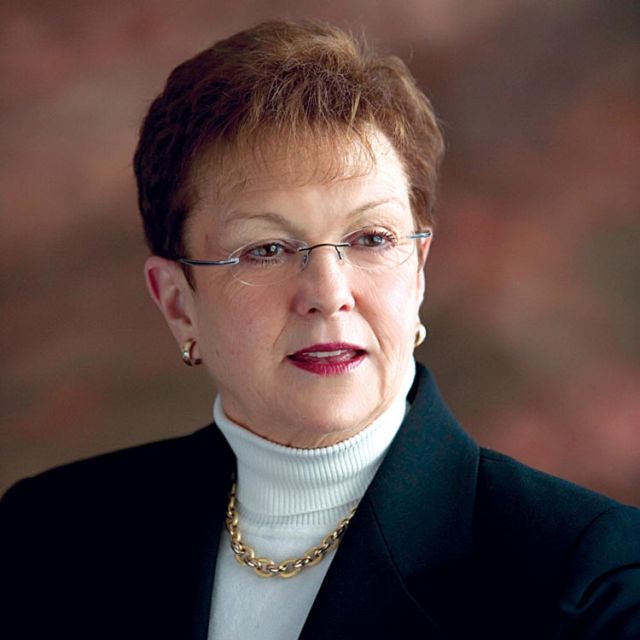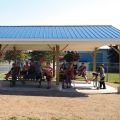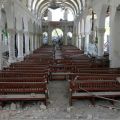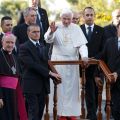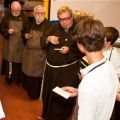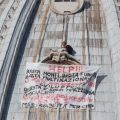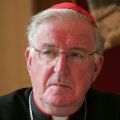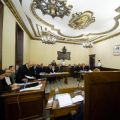NEWS
York Catholic District School Board director of education Susan LaRosa has announced that she will retire when her contract expires on Dec. 31.
“Well you know I’ve been in the education business for 45 years and I’ve enjoyed every moment of it for sure,” said LaRosa. “I have a great prayer life and the Lord told me it’s time to use my skills in a different way and after 15 years I decided to retire.”
During her career as an educator LaRosa moved up through the ranks, from teacher to principal, superintendent and most recently director of education.
She became director of education during a difficult time for the York board. Changes introduced when the Mike Harris Tories were in power brought challenges to school boards across the province in the late 1990s, and with it labour unrest.
“As a director there are always challenges that come our way,” said LaRosa. “The most satisfying part is that we’ve always been able to stand side-by-side in all the challenges and come up with a win-win solution that kept people first. That to me is the most satisfying part of my experience as a director.”
Over the years she and her colleagues worked towards “re-culturing the board” by building stronger relationships between teachers, parents and other education stakeholders.
Her attitude towards building personal relationships is what led Elizabeth Crowe, chairperson of the board, to say that LaRosa redefined the three Rs to relationships, relationships and relationships.
“Her first mandate was to do some mending of fences with our employee group that resulted in some stability in the system,” said Crowe. “That success is founded on a respect for the professionalism of all employees, a welcoming atmosphere in our schools, recog- nition of the vital role of parents, priests and the community and a commitment to fostering all levels of student leadership.”
Although LaRosa will be missed by all trustees Crowe said the board is excited to work with a new director of education.
“She will be missed but at the same time we are excited and looking forward to working with the new director of education,” said Crowe. “Over the years we’ve developed a friendship at a certain level; I wish her all the best and I know that all the other trustees feel the same way. She has always been able to see the big picture and she has always been open to working with trustees and understanding the political atmosphere that we work in.
“As chair she has made my life easy because she has been able to see that part of the educational system and she respects that.”
Since becoming the director of education LaRosa has been recognized for her dedicated work many times including with an Administrator of the Year Award from Niagara University’s College of Education, the President’s Award from The Council of Exceptional Children of York Region and in May 2009 she received The Learning Partnership’s Champion of Education Award.
Now in the homestretch of her career, LaRosa said she plans to remain an active member of the community.
“I have way too much energy to fully retire so I would like to perhaps pick and choose where I can use my talents and have not such a hectic schedule,” she said.
Her successor has yet to be named.
Community kicks in to redo Goderich school yard
By Evan Boudreau, The Catholic RegisterA new outdoor learning pavilion unveiled this September at Goderich, Ont.’s St. Mary’s Catholic Elementary School symbolizes the community’s commitment to the town’s boast that it is Canada’s prettiest town.
“That pavilion to me ... symbolizes what a community can do when it pulls together,” said Vince Trocchi, St. Mary’s principal. “There is community pride and this school is a big part of the community and that’s why it is important to them. It looks just beautiful out in our yard.”
For the past three years the local parent council had been working towards upgrading the school’s outdated playground. When opportunity to partner with the school board to build an outdoor learning pavilion came up, it seemed like a natural fit.
With the board offering to match funds raised for a pavilion, which costs between $20,000 and $25,000, the St. Mary’s Parent Council turned to members of the picturesque community on the shores of Lake Huron to meet its $10,000 fundraising goal. Most of the money was gathered during the last school year.
“The board matched our fundraising efforts and what you see is the fruits of our labour in our yard and family and students just absolutely love it,” said Trocchi.
St. Mary’s is one of 12 schools across the Huron-Perth Catholic District School Board to partner with the board to build the pavilions.
“We did it on a phase-in process because obviously the dollars needed to be allocated on a yearly basis,” said Martha Dutrizac, director of education of the Huron-Perth board. “We worked with our schools to put a plan in place that would give them the time necessary to collect their dollars.”
Funding from the board’s end came from the capital projects’ budget, said Dutrizac. Once the school’s collected cash, bids to begin construction were sought from local contractors.
The pavilions will be used not only during instructional time but also after hours by the community, provided the intended usage doesn’t conflict with Catholic values. In Goderich not only did the townspeople get behind the project, but the municipality itself offered its support.
“Our custodian made some contacts with people and they hamade some arrangement that (we could use tables that would be stored for the winter) during the school year when tables wouldn’t be in high demand,” said Trocchi. “It’s a win-win for everyone. They don’t need to store it somewhere (because) we’re actually using it and we win because there are really nice tables in our pavilion.”
Trocchi believes if he were to have called on the community again to furnish the pavilion there is no question it would have responded with open wallets.
“We are very pleased that we have this great partnership with our municipality and we are very grateful that they were able to do this for us,” he said. “It was one of those things that, yeah, we probably could have raised the money for it but we have a wonderful community that is willing to help us save those dollars for other items.
“I’m really proud of the way this community has pulled together to help make these kinds of things happen.”
Hurricane season: Church is first responder in Latin America, Caribbean
By Ezra Fieser, Catholic News ServiceSANTO DOMINGO, Dominican Republic
On the little islands that make up the Caribbean's Lesser Antilles, there is not much in the way of protection from the annual wrath of the Atlantic hurricane season. Every year from hurricane season's start on June 1 until the end of peak months — August through October — the islands are like sitting ducks.
It's a threat that Marcia Boxhill-Haywood, regional co-ordinator for Caritas Antilles, confronts with meagre tools: a $40,000 emergency fund, a small staff that mans a warehouse in St. Lucia and a handful of volunteers.
Responding to hurricanes "goes right to the heart of what the Church does because storms don't just destroy buildings, they really destroy families and communities," Boxhill-Haywood said. "In these emergencies, the Church caters to everyone that's in need, not just Catholics. We serve all denominations."
Catholic dioceses across the Caribbean, Central America and Mexico are on the frontline during hurricane season. They shelter residents during storms and serve as first responders after they have passed, handing out food, water and medicine and helping residents rebuild their lives.
Yet, preparing for the potential damage to church buildings and the financial strain of feeding mouths and housing displaced residents remains a challenge. With funds in short supply, Catholic leaders said they co-ordinate more closely with governments and other institutions and rely on volunteers and neighbouring dioceses to fill gaps.
"It's difficult because there is a lack of resources and a lack of staff," Boxhill-Haywood said. "Putting funds into preparation for hurricanes is not on the front burner."
The Caribbean basin is in the midst of an extended period of increased hurricane activity that began in 1995 and can last for several decades, according to the U.S. National Oceanic and Atmospheric Administration. Through September of this year, the Atlantic had produced 14 named storms, eight of which were hurricanes with only one being a major storm — Category 3 or greater. Yet 68 deaths were attributed to the storms and damages totaled more than $2 billion.
Climatologists predict the situation will only worsen.
"The majority (of climate models) show an increase in high category hurricanes and a decided increase in hurricane-related rainfall, a source of flooding in ... the region," Kerry A. Emanuel, a professor of atmospheric science at the Massachusetts Institute of Technology, told Catholic News Service in an e-mail.
The region woke up to the reality of an increasingly volatile hurricane season in 1998, when Hurricane Mitch lingered over much of Central America for nearly a week, dropping unprecedented amounts of rain that set off major flooding, killing thousands and causing billions in damage. By the time the storm turned back toward the Gulf of Mexico, eventually striking Florida, it had caused nearly 11,000 deaths.
Church leaders said the region has made strides since Mitch in preparing for disastrous hurricanes and tropical storms.
However, in Central America, where the majority is poor, dioceses often find themselves shorthanded when a disaster strikes. Deep in Nicaragua's Mosquito Coast, Bishop Paul Schmitz Simon of Bluefields worries about the effects of hurricanes every year. Yet, his diocese, roughly 60,000 square kilometres, has no money set aside for the next storm.
"We don't have the resources to put some money away for a hurricane," he said. "We rely on other organizations and on our relationship with the government."
Schmitz's approach underscores the reality in which many dioceses find themselves: Short on cash to devote to hurricane preparedness, they count on other institutions and volunteers.
It's a system Schmitz has honed since Hurricane Joan hit the coast as a powerful category 4 storm Oct. 22, 1998. It killed 148 people before leaving the Central American country as a weakened tropical storm.
Schmitz said the region is about 50 per cent better prepared today than it was when Hurricane Joan hit.
Despite the lessons learned, in 2007 Hurricane Felix destroyed homes and flooded farmland. It destroyed most of the rural coastal town of Puerto Cabezas.
"I would like to say that we learned from it," Schmitz said. "We started building from concrete block and using building methods that can withstand hurricanes."
Constructing buildings to sustain the impact of hurricanes, however, is more costly and time consuming than the methods many have used for years.
In Haiti, a program to reconstruct church buildings destroyed by the January 2010 earthquake only recently doled out its first grants. The PROCHE, or Partnership for Church Reconstruction in Haiti, process requires new buildings to meet modern standards, designed to withstand earthquakes and hurricanes.
Rebuilding "intelligently and safely" is of the utmost importance, Archbishop Thomas G. Wenski of Miami said June 3 near the conclusion of a conference on rebuilding Haiti.
It was a lesson Fr. Sean Doggett on the small Caribbean island of Grenada learned firsthand. On Sept. 7, 2004, Hurricane Ivan hit the island as a Category 3 storm, damaging 95 per cent of buildings in some areas.
"In the parish where I am, there was not a house without a roof that needed at least to be repaired. Two of the (four) churches needed to be totally demolished and rebuilt, and a third needed a new roof," said Doggett of the Our Lady Help of Christians parish in Beaulieu, Grenada.
The storm was devastating, but help quickly poured in from the government, international donors and, more immediately, from neighbouring islands.
Doggett said volunteers were key links in properly distributing aid.
"I can boast that for the first month or two, the Church was much better at distributing (aid) than the government or other groups," thanks in part to the volunteer network, he said.
Today, the parish and island are far better prepared to withstand and respond to a hurricane, Doggett said.
"There is generally much more awareness of hurricanes and more information on how to prepare," he said.
In terms of construction, "there was a lot of consideration put into the standards after Ivan," he said. "The new standards require things like the use of hurricane straps and reinforcements ... for all buildings, from the smallest on up."
Pope authorizes granting of indulgences for Year of Faith events
By Francis X. Rocca, Catholic News ServiceVATICAN CITY - Catholics who participate in events connected with the 2012-2013 Year of Faith can receive a special indulgence, the Vatican said.
Pope Benedict XVI authorized the granting of a plenary, or full, indulgence in order to highlight the Year of Faith and encourage the "reading, or rather, the pious meditation on" the documents of the Second Vatican Council and the Catechism of the Catholic Church, a Sept. 14 Vatican decree said.
The decree, which the Vatican released Oct. 5, was signed by Cardinal Manuel Monteiro de Castro, head of the Vatican tribunal that deals with indulgences and with matters related to the sacrament of penance.
An indulgence is a remission of the temporal punishment a person is due for sins that have been forgiven.
Pope Benedict established the Year of Faith, "dedicated to the profession of the true faith and its correct interpretation," to run from Oct. 11, 2012 to Nov. 24, 2013. It begins on the 50th anniversary of the opening of Vatican II, which is also the 20th anniversary of the publication of the catechism.
The plenary indulgence is being offered to pilgrims who visit sacred shrines, to Catholics who participate in local events connected to the Year of Faith, and to those who may be too ill or otherwise prevented from physical participation. It can be granted on behalf of the individual petitioner or on behalf of departed souls.
The decree said conditions for the special Year of Faith indulgence include the normal requirements set by the Church for all plenary indulgences: that the person goes to confession, receives the Eucharist and prays for the intentions of the Pope.
The decree explained in detail some specific requirements for the plenary indulgence:
— Those visiting basilicas, cathedrals, catacombs or other sacred sites in the form of a pilgrimage must participate in a liturgy, "or at least pause for an appropriate time in prayer and with pious meditations, concluding with the recitation of the Our Father, the profession of faith in any legitimate form, invocations of the Blessed Virgin Mary and, where appropriate, of the Holy Apostles or patron saints."
— The Catholic faithful in any local church can obtain the indulgence by attending three sermons at parish missions or three lectures on Vatican II or the catechism; attending Mass or the Liturgy of the Hours on days designated by the local bishop for the Year of Faith; or visiting the place where they were baptized to renew their baptismal vows.
— Catholics who attend Mass celebrated by a bishop on the Year of Faith's last day, the feast of Christ the King, will also receive the indulgence, as will those impeded by sickness or other serious cause from attending the Mass, as long as they are truly repentant and pray while listening to the bishop bestow the indulgence via television or radio.
COLF exhorts families to engage in new evangelization
By Deborah Gyapong, Canadian Catholic NewsOTTAWA - To mark the Synod on New Evangelization taking place in Rome Oct. 7-28 and the beginning of the Year of Faith, the Catholic Organization for Life and Family (COLF) has released a leaflet urging families to spread the Good News.
In “The Gospel of Everyday Life: an Adventure Worth Sharing,” COLF explains the role of the family as a domestic Church as well as that of lay faithful in evangelizing in light of the teachings of the Second Vatican Council and Scripture.
For decades, Catholic Church leaders have been calling for the new evangelization — “new in its ardour, new in its methods and means of expression” because “too many of the baptized live as if God does not exist,” COLF says.
“Their way of life, their opinions, their choices are aligned with an atheistic or relativistic vision of life.”
Not only baptized Catholics need to hear “Christ spoken of seriously” but so do those “with whom we rub shoulders at work, school or university, in the shopping mall, the subway or bus, in our leisure and volunteer activities."
Woven throughout with quotes from Pope John Paul II and Pope Benedict XVI, the leaflet urges people to collaborate with Christ in introducing Him to family members, friends and others.
The leaflet suggests a gentle, humble approach rather than aggressive proselytizing or imposing one’s faith on others. COLF invites Catholics to deepen their personal relationship with Jesus Christ through prayer, study of the faith and more frequent participation in the Eucharist and the sacrament of Reconciliation.
COLF focuses on Jesus the Son of God, laying out the Gospel message in a way that makes it easy to share with others. Invite Catholics who have fallen away to come back to Church, and invite others to “come and see” and be prepared for when a friend might ask, “What must I do?” to know Christ.
Evangelization is not just for priests, bishops and those in religious life, COLF insists, but is part of the call of all the baptized. It’s also the call of families as domestic churches, the leaflet says.
“God is counting on us, as parents, to make our children apostles of the new evangelization,” it says. “Whoever speaks of evangelization is obviously speaking about relationships, because we must enter into relationship with another person to be able to share with him or her the secret of our happiness.
“By nature, we are relational beings, because we are created in the image of God — Father, Son and Holy Spirit, eternally in relationship,” COLF says.
Evangelization, especially in the family, is not composed of “great speeches or theoretical lessons but through everyday love, simplicity and daily witness.”
The leaflet has a section entitled “Riddle time!” that has a question and answer format that is easy to share with children. It also includes a page with discussion questions for adults that would be appropriate for small group discussion.
The document is downloadable from Colf's web site at www.colf.ca. A workshop guide is also available.
Franciscans court 'Lady Poverty' at St. Francis Table
By Michael Swan, The Catholic RegisterTORONTO - On the Feast of St. Francis of Assisi Toronto's Capuchin friars came courting "Lady Poverty" in Parkdale, where they've been courting her the past 25 years.
"Lady Poverty" was how St. Francis, in the courtly language of the 13th century, conceived of life with and among the poor. Today's Franciscan Capuchins serve "Lady Poverty" by dishing up ravioli, salad, chili con carne and bread with coffee and dessert for $2 at St. Francis Table in the heart of Parkdale, in the city's west end.
There were seven local Capuchins at St. Francis Table serving lunch on Oct. 4. They were there to share a Franciscan feast with the poor and to honour the 25th anniversary of the Franciscan restaurant.
Since it opened Christmas 1987 there's never been much doubt about the Franciscan and Christian foundations of St. Francis' Table, said provincial superior Fr. David Connolly. But "the neighbourhood is changing," he said.
It had always been the Franciscans' intention to hand St. Francis' Table off to lay people with the drive and the ability to sustain the work. That would free up the religious order to launch new ventures.
Watching new condo towers encroach and local businesses replaced with chi-chi restaurants, Connolly thinks that day may be coming soon.
"We would certainly consider moving where the poor move... when the time comes," he said.
In the meantime, St. Francis' Table is having no trouble filling the dining room with people who need a good meal, good company and some encouragement.
Robert Tait has been coming to St. Francis Table the last six months and describes it as "a good place to be."
"It grounds me. It helps me to stay strong in my faith," he said.
St. Francis' Table also has an important ministry to thousands of young volunteers, said Grade 10 religion teacher Mark Henry. On the Feast of St. Francis, Henry brought nine of his Our Lady of the Lake students from Keswick, Ont., to get a more realistic picture of poverty.
"It opens their eyes," he said.
Noting a couple with a child in a stroller who had come for lunch, Henry said he hoped his students understood that the poor are not so different from their own middle-class families.
"It's not the cliché thing. None of us are that far away from poverty," he said.
Numbers not good, but passion is high for Billings Method
By Vanessa Santilli-Raimondo, The Catholic RegisterTORONTO - Dr. Karen Stel made the “wonderful discovery” of natural family planning during her medical residency and to this day the Toronto doctor refuses to prescribe birth control pills. Instead, she recommends the Billings Ovulation Method of natural family planning to her patients.
“It’s a a co-operative way of working with your body the way that God designed it,” said Stel. “To be able to control fertility is an amazing thing that God has given us.”
Stel was a participant at a Sept. 28 Billings Ovulation Method workshop for medical professionals in Toronto. She’d come to hear Dr. Mary Martin, of the Billings Centre for Fertility and Reproductive Medicine in Oklahoma City, who was in Toronto at the invitation of the Natural Family Planning Association, funded by Catholic Charities of the Archdiocese of Toronto.
But the workshops had a low turnout, with just five health professionals attending the breakfast session and eight at the lunch session. Stel, a general practitioner, was the only medical doctor to attend. Participants included Billings teachers, homeopaths, naturopathic doctors, nurses and a social worker.
The Billings Method teaches couples to observe the natural biological signs of female fertility and use that knowledge to postpone or achieve pregnancy, said Martin.
Christian Elia, acting executive director of the Natural Family Planning Association which organized the event, said the workshops were open for all medical professionals to attend.
“I’m disappointed but I’m constantly disappointed that more doctors don’t take the Billings Ovulation Method seriously despite the fact that it’s been around for decades and it’s already used successfully by millions of people around the world,” he said.
Elia said the majority of medical professionals in Toronto are not receptive to the Billings Method.
“It wasn’t part of their training so… most doctors just feel more comfortable doing what they’ve been told which usually involves prescribing birth control pills.”
To reverse that, Stel believes natural family planning should be taught in medical schools.
Struggling with the issue of contraception during her residency at Queen’s University, Stel got in touch with the natural family planning community in Kingston, Ont., and eventually carried out a research project on the efficacy of the Billings Method as compared to contraception.
“I presented in 2001 to my colleagues at Queen’s and received very good feedback,” said Stel, an evangelical Christian. “It was enough to convince me that I could practise medicine with integrity.”
But it hasn’t been all smooth sailing. Recently, a patient filed a complaint with the College of Physicians and Surgeons of Ontario when Stel refused to prescribe birth control. It took about eight months to settle, but in the end, the college voted in her favour.
“I’ve had to be careful after that but at the same time it doesn’t change my conviction. If anything, it affirms it. If you’re getting opposition, they say you’re doing something right.”
Similarly, Martin said a lot of Catholic physicians don’t know how to practise gynecology without prescribing pills. She stopped promoting birth control after a conversion experience. For her penance, a priest made her research whether the pill can cause miscarriages and induce abortions. She discovered this was a possibility.
“I had learned in medical school that there was that potential,” she said. “But I had been assured by the drug companies over the years that was a very uncommon thing.”
By 1999, she had stopped prescribing birth control. She was worried her clients would leave.
“It was like standing on the precipice with my toes curled over the edge and my arms spread out saying, ‘Okay, God, catch me if I fall.’ And He did.”
Rose Heron, program director of the Natural Family Planning Association, said doctors are often introduced to the Billings Method by patients who practise the Billings Method.
“Keep in mind that we live in a society where, if a couple is trying to achieve pregnancy and they don’t within the prescribed time, many doctors just send you for in-vitro fertilization. So they move onto technological means. And many couples are looking for an alternative to that.”
Pauline MacCarthy Phelps, a visiting Billings co-ordinator from Trinidad and Tobago, says advertising of the Billings Method must be improved in order to attract more people to the option.
“It’s not common,” she said. “What’s common is contraception. Nobody wants to have 10 children and contraception is what they know about and it’s popular.”
Lori Canlas, a social worker and psychotherapist, also believes Billings needs to be promoted further. But what struck her was the negative impact of contraception on women’s health.
“It’s also highly interesting that doctors highly prescribe contraception without knowing other alternatives… There is an option for them to choose something more natural.”
Stel remains optimistic that medical professionals will become more open to natural family planning.
“They respect me for this… It will just take more doctors (to show others). And doctors that have time. The reality right now is that I don’t have time. But I do, wherever I can.”
Man protesting government economic policies climbs St. Peter's dome
By Cindy Wooden and Francis X. Rocca, Catholic News ServiceVATICAN CITY - A 49-year-old Italian man protesting the economic policies of Italy and Europe scaled a fence on top of the dome of St. Peter's Basilica Oct. 2 and remained perched above a window for 28 hours, even during Pope Benedict XVI's weekly general audience in the square below.
With the help of two Vatican firefighters and the rope he had tied around himself, the protester, Marcello Di Finizio, climbed back up to the public walkway on top of the dome about 8 p.m. local time. He was escorted to a nearby Italian police station for what he told The Associated Press were "formalities."
Pope Benedict did not mention the protester, Marcello Di Finizio, during his audience talk.
Di Finizio, who had scaled the fence on the dome in July as well, runs a beachfront business in northern Italy, renting umbrellas and chaise lounges. He has been protesting Italy's plan to obey European Union directives by holding public auctions to distribute licenses to operate such businesses on public beaches.
Shortly after the Pope's general audience ended, Catholic News Service reached Di Finizio on his cellphone. Speaking from the dome, he told CNS: "I'm here to ask for help. Our government, our state, doesn't exist. Sectors of the economy, the beach sector, have been paralysed for years by government policies.
"I ask for political asylum from the Vatican," he said. "The Pope is the highest ethical and moral authority in this country, or at least he should be — let's hope he still is."
Di Finizio, who was wearing an Italian flag around his neck, said he would not come down until government officials and labour union officials promised to sit down with him and resolve the serious economic issues facing Italians who work in the tourism sector.
The protester said he felt forced to take his protest public in a highly visible fashion.
"I want to live; I like living," he said, but "if they want to kill me, let them do it in front of millions of people."
Di Finizio implied he could be willing to jump from the dome. When others are driven to such desperate measures, he said, "these are not suicides, these are homicides."
When a CNS reporter suggested that his message had been heard and he could come down, Di Finizio laughed and said: "In your country, maybe that would work, but we're in Italy. Here they will slap me on the back, kick me in the rear and not listen any more."
Then Di Finizio made a request, "Please ask the Pope to send up an electrical cable so that my phone battery doesn't go dead and I can keep talking to (all of) you."
Jesuit Father Federico Lombardi, Vatican spokesman, said Di Finizio obviously was not mentally stable.
Vatican firefighters and police officers remained on the public walkway around the top of St. Peter's dome throughout the night and into Oct. 3 as Di Finizio's protest continued.
Di Finizio had joined a group of tourists going to the top of St. Peter's Basilica at about 5 p.m. Rome time Oct. 2. Security cameras showed him climbing over the 1.5-metre-high fence, tying a rope around himself and lowering himself down to a large decorative overhang above one of the dome's windows. He also managed to unfurl and tie down a large banner to the dome that said "Help!" and called for an end to policies that were "butchering society."
British cardinal says Pope prevented him from joining House of Lords
By Simon Caldwell, Catholic News ServiceMANCHESTER, England - Pope Benedict XVI personally intervened to prevent a British cardinal from occupying political office when he retired from active ministry, the cardinal said.
Cardinal Cormac Murphy-O'Connor, retired archbishop of Westminster, said the British government was considering appointing him as a member of the House of Lords after he reached 75, the retirement age for bishops and cardinals. However, Pope Benedict opposed the idea because he did not wish to set a precedent that might have been copied by bishops in South America and Africa who wished to join the governments of their countries, the cardinal said in an interview published by the London-based Sunday Telegraph.
Under Church law, Canon 285 prohibits clerics from holding political office.
"The idea was quite attractive," Murphy-O'Connor, 80, told the newspaper.
"I consulted the Pope and his chief advisor and they were against it. It's to do with having the freedom to be outside the political system."
Asked if the Pope had personally blocked him from becoming a Lord, the cardinal answered: "Yeah, more or less."
The British Constitution allows Anglican bishops to sit as "lords spiritual" or "spiritual peer" in the House of Lords in a practice that pre-dates the Reformation. It would be normal for the archbishop of Canterbury to join the House of Lords on retirement as leader of the worldwide Anglican Communion.
Murphy-O'Connor said he was tempted to become a spiritual peer, in which he would have been given the title "Lord," after his 2009 retirement from Westminster because he saw the need for Christians to be active in public life.
The cardinal also discussed his views on religion and its role in modern society in the interview.
"Christianity is important in this country," he told the newspaper. "It has to stand up for itself in the face of secularism. We must be brave enough to speak intelligently about what we believe. We must combat aggressive secularism, because it is dangerous."
The cardinal added: "Nobody is obliged to be a Christian, but no one should be obliged to live according to the new secular religion, which says it alone decides what's right."
Vatican investigates conditions of butler's detention
By Cindy Wooden, Catholic News ServiceVATICAN CITY - Paolo Gabriele, the papal butler on trial in the Vatican, told judges that for 20 days he was held in a tiny cell where he could not even fully extend both arms and where Vatican police kept the lights on 24 hours a day.
Gabriele's testimony about the conditions of his detention after his arrest in May came in response to questions posed by his lawyer Oct. 2, the second day of his trial on charges of aggravated theft for allegedly stealing reserved papal correspondence and leaking it to a reporter.
After the testimony, Jesuit Father Federico Lombardi, Vatican spokesman, said the Vatican court had ordered an investigation into the claims.
The Gendarme Corps of Vatican City State, as the Vatican police force is formally known, issued a statement saying that Gabriele was held in a small cell for 20 days while previously scheduled remodeling work was sped up and completed on a larger room for prisoners. The police said the work included improvements "responding to the requirements requested by the Convention Against Torture," a 1984 international agreement, which the Vatican signed.
As for the lights being left on, the police said the decision was made that it was a necessary precaution to ensure that Gabriele did not hurt himself. The statement added, however, that Gabriele was given a sleep mask.
Gabriele's Vatican physician made regular visits, the statement said, adding that Gabriele even told the doctor that he was "resting peacefully" and, in fact, was not as nervous as he had been before his arrest.
Complete meals were delivered to him three times a day, and he ate them in the company of police officers. He was taken outside each day and offered use of the police gym, although he declined that offer. Each day included "moments of relaxation and socialization with personnel from the Gendarme Corps with whom, for obvious reasons," he previously enjoyed a friendship. The officers, like Gabriele, worked together in the Vatican and accompanied the Pope at audiences and on trips.
The police also said Gabriele had "constant contact" with his spiritual advisors; he was escorted to Mass with his family and was able to visit with his family or meet with his lawyers almost any time he wanted.
The police statement said that if the Vatican investigation into the treatment of Gabriele demonstrates that his accusations are unfounded, the police would consider suing him.
Police testify papal butler's apartment crammed with documents
By Carol Glatz and Cindy Wooden, Catholic News ServiceVATICAN CITY - Vatican police officers who searched Paolo Gabriele's apartment testified they found "an infinite amount" of documents and news clippings covering a vast range of topics, including the Masons, the Vatican bank and yoga.
Although they sequestered 82 moving boxes full of materials, once the police inspected all the paper, only a fraction of the material was deemed relevant to the case, officers told a three-judge panel on the third day of the "VatiLeaks" trial.
Vatican judges said they would hear closing arguments Oct. 6; a verdict was possible the same day.
Each of the four police officers testifying Oct. 3 also said they did not wear gloves during the search, saying that was not the usual protocol for conducting a search and seizure of paper.
In the court's brief morning session, the four officers testifying were Stefano De Santis, Silvano Carli, Luca Bassetti and Luca Cintia, vice commissioner of the Vatican police force.
The four men were among the officers who conducted the search of Gabriele's Vatican apartment May 23 and arrested Gabriele that evening. The officers were among eight witnesses all called by the defense to testify in the trial of the former papal assistant, who has been charged with aggravated theft for allegedly stealing and leaking papal correspondence and other sensitive documents.
Gabriele was present in the courtroom during their testimony.
Each officer took the stand while his colleagues waited outside. Each of the officers was asked to describe how the search was conducted, which officers searched which rooms of Gabriele's Vatican apartment and what was found where.
The search started just before 4 p.m. and ended close to midnight. De Santis said he suggested to Gabriele that it would be better for his wife and children, who were home at the time, to leave for awhile because the potentially disturbing event "would be engraved in their memories."
Gabriele declined, and he, his wife and three children stayed in the apartment during the search.Two of the officers were called only later to help with the search. Even while other officers continued to go through Gabriele's home office, the two were asked to check the children's rooms for potential material and to do it quickly so the children could go to bed.
De Santis said the officers also told Gabriele he should phone a lawyer, and he immediately called Carlo Fusco, his childhood friend. Fusco left the defense team in August, saying he and Gabriele had irreconcilable differences of opinion about defense strategy.
The officers said that during the search Gabriele said, "See how much I like to read and study?" But he also apologized that the amount of material in his house "will keep you at work late," and he offered them coffee and water.
Gabriele was taken into police custody around 8 p.m.
In his testimony, De Santis said he realized the seriousness of the alleged crime when they discovered materials matching those leaked to an Italian journalist, who had published them in a book.
"At that point we decided to take away everything" that looked remotely related, and they alerted the head of the Vatican police corps, Domenico Giani.
Highly sensitive materials, including encrypted cables from Vatican nuncios, were "well-hidden" among piles of paper stuffed in cabinets, shelves and ceiling-high closets, he and the other police witnesses said.
Gabriele allegedly leaked a large number of sensitive documents to an Italian journalist who published them in a book early May. De Santis testified that the publication of even one of the coded and deciphered cables could have compromised the Vatican encryption system.
Only a small fraction --"more than 1,000 pages" -- of the materials was determined to be relevant to the case, Carli testified. Some of that material involved information about the private life of the papal household, letters from cardinals to the pope and written replies from the pope. Some documents with the pope's signature were marked in German, "Destroy," two of the officers testified.
The majority of the documents were pages printed off the Internet and news clippings covering a vast array of topics. Gabriele's lawyer, Cristiana Arru, questioned each officer about how much material was found in the apartment and where it had been discovered. In addition to the 82 boxes -- each measuring about 15 inches by 23 inches -- police carried away two black leather suitcases and two "big yellow bags" filled with materials.
Arru told reporters after the hearing that she wanted to show that it was physically impossible for that amount of material to have been in Gabriele's home.
Arru was rebuffed by the main judge, Giuseppe Dalla Torre, when she continued to ask the police whether they were present at the search of Gabriele's quarters at the papal summer residence in Castel Gandolfo. Dalla Torre said repeatedly that the results of the Castel Gandolfo search were not relevant to the case because a Vatican tribunal's jurisdiction only covers crimes committed in Vatican City State.
Police also confiscated one desktop computer, two or three laptops, "many" USB memory pen drives, one iPod, two hard disks and a PlayStation from Gabriele's Vatican apartment, police said. De Santis said police still have not finished examining all of the information on the computers.

